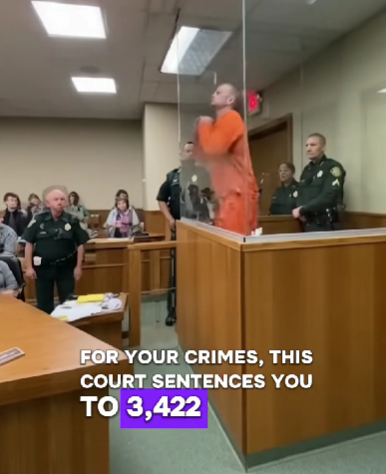
A dramatic courtroom moment has gone viral after a judge issued an astonishing 3,422-year prison term to a convicted offender — a ruling that left onlookers speechless and set off a nationwide debate about extreme sentencing and what such massive numbers truly represent.
The video captures the defendant, dressed in an orange jail jumpsuit, standing inside a secure glass booth as the judge announces the ruling. As the sentence is read, the room falls into stunned silence. The man shifts anxiously, appearing unsettled, while deputies stationed nearby remain vigilant in case the situation escalates.
Authorities have not publicly detailed every charge included in the case, but officials explained that the unprecedented length stems from the sheer number and seriousness of the offenses. When multiple victims or repeated crimes are involved, judges often issue consecutive sentences — stacking one punishment after another — which can result in enormous totals. While no human could serve thousands of years, these sentences effectively guarantee that the individual will never qualify for parole or early release.
According to legal analysts, sentences of this scale serve several important purposes:
• They acknowledge each victim individually, ensuring every offense is formally recognized.
• They safeguard against future legal changes that could shorten a sentence.
• They send a clear message that extremely harmful crimes will be met with the harshest possible consequences.
Public reaction has been sharply divided. Some viewers praise the judge’s decision, seeing it as a justified response that brings closure to those affected. Others argue that thousand-year sentences are more symbolic than functional, raising questions about the goals of the justice system and whether rehabilitation should ever be considered for severe offenders.
Emotions in the courtroom were intense. Relatives of victims were present, many tearing up or holding each other as the sentence was delivered. For them, the ruling represents more than a number — it reflects accountability, recognition of suffering, and the belief that justice was fully served.
Extreme sentences like this are uncommon, but they tend to appear in cases involving prolonged harm, repeated acts of violence, or multiple victims. Consecutive sentencing is often used when courts aim to protect the public permanently.
The defendant’s behavior in the video also drew attention online. He appears restless and visibly distressed, occasionally shouting as officers monitor him closely. Viewers noted that hearings of this magnitude can be highly charged, with emotions running high on all sides.
As the clip continues to spread, one thing is certain: the extraordinary 3,422-year sentence has sparked widespread reflection on how society defines justice for the most serious crimes — and whether such symbolic rulings are necessary, excessive, or both.



